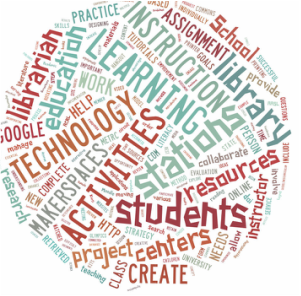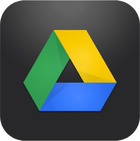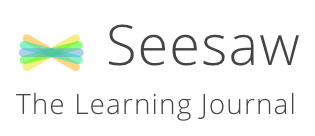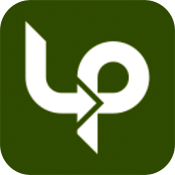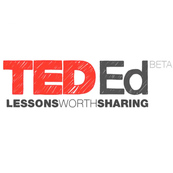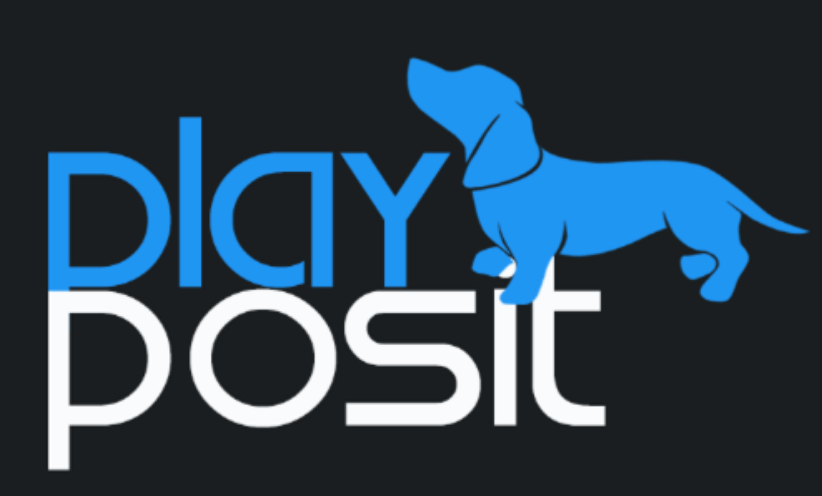Using Stations and Centers to Activate LearningWHY?
|
Rotating StationsIn small groups, students move among stations in any order but must go to each station to complete an activity, project, or assessment. Preferably, activities at the stations are dependent on students completing them cooperatively.
|
Progressive StationsStudents complete stations in a specific order to learn a skill or concept broken down into separate learning segments. Methods include using multiple stations with the same activity (i.e. station 1a, station 1b, station 2a, station 2b, etc.), implementing stations over multiple days with another learning activity happening in class (i.e. consultations with student groups, group work on a project, etc.), or by moving stations online using technologies like Moodle and Google Hangouts
|
Independent StationsAn instructor and/or librarian constructs learning activities for students to complete via packets of information, tutorials, diagrams, learning technologies, and so on. Students choose stations and therefore complete activities based on their needs.
|
Technology To Make Stations Flow
Creating websites to unite stations or using an LMS like Edmodo, Moodle, Blackboard, etc. can help students easily find directions and keep the stations organized. The examples below include technologies that we use to make our stations more organized for student use. Here is a general listing of technologies helpful in stations:
|
Google Drive - Use forms to have students reflect on learnings throughout stations. Use docs and ask students to take notes. Have students upload files to drive when they complete a station assignment.
|
Google Hangout - For online stations ask students to "meet" in Google Hangout and complete a series of activities together. Include a guest speaker at a station via Google Hangouts.
|
LMS - Edmodo - Organize stations as small groups in Edmodo and then include directions, handouts, activities, feedback polls, etc. in the small groups for each station.
|
Seesaw - an online portfolio creator and blog appropriate for K-5 and higher levels. Use to organize stations by asking students to post learning as image, text, video, etc. in different groups set up for each station.
|
|
Blendspace - Create a Blendspace with tutorials, readings, open-ended questions, etc. mixed together and students can provide feedback, ask questions, etc. as they use the Blendspace or Lesson Paths
|
PlayPosit or EdPuzzle , TEDEd or Videono.tes - Upload your tutorials or other significant videos important at stations but use a secondary tool so students can answer questions, take notes and otherwise engage with the videos.
|
References
AASL (American Association of School Librarians). (2007) Standards for the 21st-century learner. Retrieved October , 2014, from http://www.ala.org/aasl/standards-guidelines/learning-standards
Abram, S. (2013). Makerspaces in libraries, education, and beyond. Internet@schools, 20(2), 18-20,4. Retrieved from http://search.proquest.com.prox.lib.ncsu.edu/docview/1317184356?accountid=12725
ACRL (Association of College & Research Libraries). 2009. Guidelines for curriculum materials centers. Chicago: Association of College & Research Libraries. Retrieved October 1, 2014 from http://www.ala.org/acrl/standards/guidelinescurriculum
---. 2013. Guidelines for university library services to undergraduate students. Chicago: Association of College & Research Libraries. Retrieved October 1, 2014 Retrieved from http://www.ala.org/acrl/standards/ulsundergraduate
Brisco, S. (2012). Staying relevant: Re-engineering for the future. In R. Kohrman (Ed.), Curriculum materials collections and centers: Legacies from the past, visions of the future (pp. 199) The Association of College and Research Libraries.
Callison, D. (2006). Project-based learning. School Library Media Activities Monthly, 22(5), 42-45. Retrieved from http://search.proquest.com.prox.lib.ncsu.edu/docview/237134596?accountid=12725
Canino-Fluit, A. (2014). School library makerspaces. Teacher Librarian, 41(5), 21. Retrieved from http://search.ebscohost.com/login.aspx?direct=true&db=f6h&AN=96678450&site=ehost-live&scope=site
Chickering, A. W., Gamson, Z. F., & American Association for, H. E. (1987). Seven principles for good practice in undergraduate education. AAHE Bulletin, , 3-7. Retrieved from http://search.ebscohost.com/login.aspx?direct=true&db=eric&AN=ED282491&site=ehost-live&scope=site
Daniels, H., 1947-. (2005). Teaching the best practice way: Methods that matter, K-12. Portland, Me.: Stenhouse Publishers.
Farthing, P., & Gregor, M. N. (2012). Promoting library instruction for education students: A model for CMC/Faculty collaboration. In R. Kohrman (Ed.), Curriculum materials collections and centers: Legacies from the past, visions of the future (pp. 59-74) The Association of College and Research Libraries.
Gogus, A. (2012). Active learning. In Encyclopedia of the Sciences of Learning, (pp. 77-80) Springer US. doi:10.1007/978-1-4419-1428-6_489
Gregory, G. (2013). Differentiated instructional strategies: One size doesn't fit all. Thousand Oaks, California: Corwin.
Kurti, R. S., Kurti, D. L., & Fleming, L. (2014). The philosophy of educational makerspaces part 1 of making an educational makerspace. Teacher Librarian, 41(5), 8-11. Retrieved from http://search.proquest.com.prox.lib.ncsu.edu/docview/1548230083?accountid=12725
Miller, J. L., & Meyer, N. (2012). The value of the curriculum center's mission statement: Meeting the needs of evolving teacher education. In R. Kohrman (Ed.), Curriculum materials collections and ceners: Legacies from the past, visions of the future (pp. 167) The Association of College and Research Libraries.
Miller, S. (2014, February 9). The library voice: "Project 3D olympics"......5th graders research olympics and create new symbols with the makerbot 3D printer. Retrieved from http://vanmeterlibraryvoice.blogspot.com/2014/02/project-3d-olympics5th-graders-research.html
National Governors Association Center for Best Practices. (2010). Common core state standards. Washington D.C.: National Governors Association Center for Best Practices.
Preddy, L. (2013). Creating school library "makerspace". School Library Monthly, 29(5), 41-42. Retrieved from http://search.proquest.com.prox.lib.ncsu.edu/docview/1492553683?accountid=12725
Tomlinson, C. A. (1999). The differentiated classroom : Responding to the needs of all learners. Alexandria, Va.: Association for Supervision and Curriculum Development.
Wormeli, R. (2007). Differentiation : From planning to practice, grades 6-12. Portland, Me.; Westerville, Ohio: Stenhouse Publishers; National Middle School Association.
AASL (American Association of School Librarians). (2007) Standards for the 21st-century learner. Retrieved October , 2014, from http://www.ala.org/aasl/standards-guidelines/learning-standards
Abram, S. (2013). Makerspaces in libraries, education, and beyond. Internet@schools, 20(2), 18-20,4. Retrieved from http://search.proquest.com.prox.lib.ncsu.edu/docview/1317184356?accountid=12725
ACRL (Association of College & Research Libraries). 2009. Guidelines for curriculum materials centers. Chicago: Association of College & Research Libraries. Retrieved October 1, 2014 from http://www.ala.org/acrl/standards/guidelinescurriculum
---. 2013. Guidelines for university library services to undergraduate students. Chicago: Association of College & Research Libraries. Retrieved October 1, 2014 Retrieved from http://www.ala.org/acrl/standards/ulsundergraduate
Brisco, S. (2012). Staying relevant: Re-engineering for the future. In R. Kohrman (Ed.), Curriculum materials collections and centers: Legacies from the past, visions of the future (pp. 199) The Association of College and Research Libraries.
Callison, D. (2006). Project-based learning. School Library Media Activities Monthly, 22(5), 42-45. Retrieved from http://search.proquest.com.prox.lib.ncsu.edu/docview/237134596?accountid=12725
Canino-Fluit, A. (2014). School library makerspaces. Teacher Librarian, 41(5), 21. Retrieved from http://search.ebscohost.com/login.aspx?direct=true&db=f6h&AN=96678450&site=ehost-live&scope=site
Chickering, A. W., Gamson, Z. F., & American Association for, H. E. (1987). Seven principles for good practice in undergraduate education. AAHE Bulletin, , 3-7. Retrieved from http://search.ebscohost.com/login.aspx?direct=true&db=eric&AN=ED282491&site=ehost-live&scope=site
Daniels, H., 1947-. (2005). Teaching the best practice way: Methods that matter, K-12. Portland, Me.: Stenhouse Publishers.
Farthing, P., & Gregor, M. N. (2012). Promoting library instruction for education students: A model for CMC/Faculty collaboration. In R. Kohrman (Ed.), Curriculum materials collections and centers: Legacies from the past, visions of the future (pp. 59-74) The Association of College and Research Libraries.
Gogus, A. (2012). Active learning. In Encyclopedia of the Sciences of Learning, (pp. 77-80) Springer US. doi:10.1007/978-1-4419-1428-6_489
Gregory, G. (2013). Differentiated instructional strategies: One size doesn't fit all. Thousand Oaks, California: Corwin.
Kurti, R. S., Kurti, D. L., & Fleming, L. (2014). The philosophy of educational makerspaces part 1 of making an educational makerspace. Teacher Librarian, 41(5), 8-11. Retrieved from http://search.proquest.com.prox.lib.ncsu.edu/docview/1548230083?accountid=12725
Miller, J. L., & Meyer, N. (2012). The value of the curriculum center's mission statement: Meeting the needs of evolving teacher education. In R. Kohrman (Ed.), Curriculum materials collections and ceners: Legacies from the past, visions of the future (pp. 167) The Association of College and Research Libraries.
Miller, S. (2014, February 9). The library voice: "Project 3D olympics"......5th graders research olympics and create new symbols with the makerbot 3D printer. Retrieved from http://vanmeterlibraryvoice.blogspot.com/2014/02/project-3d-olympics5th-graders-research.html
National Governors Association Center for Best Practices. (2010). Common core state standards. Washington D.C.: National Governors Association Center for Best Practices.
Preddy, L. (2013). Creating school library "makerspace". School Library Monthly, 29(5), 41-42. Retrieved from http://search.proquest.com.prox.lib.ncsu.edu/docview/1492553683?accountid=12725
Tomlinson, C. A. (1999). The differentiated classroom : Responding to the needs of all learners. Alexandria, Va.: Association for Supervision and Curriculum Development.
Wormeli, R. (2007). Differentiation : From planning to practice, grades 6-12. Portland, Me.; Westerville, Ohio: Stenhouse Publishers; National Middle School Association.
